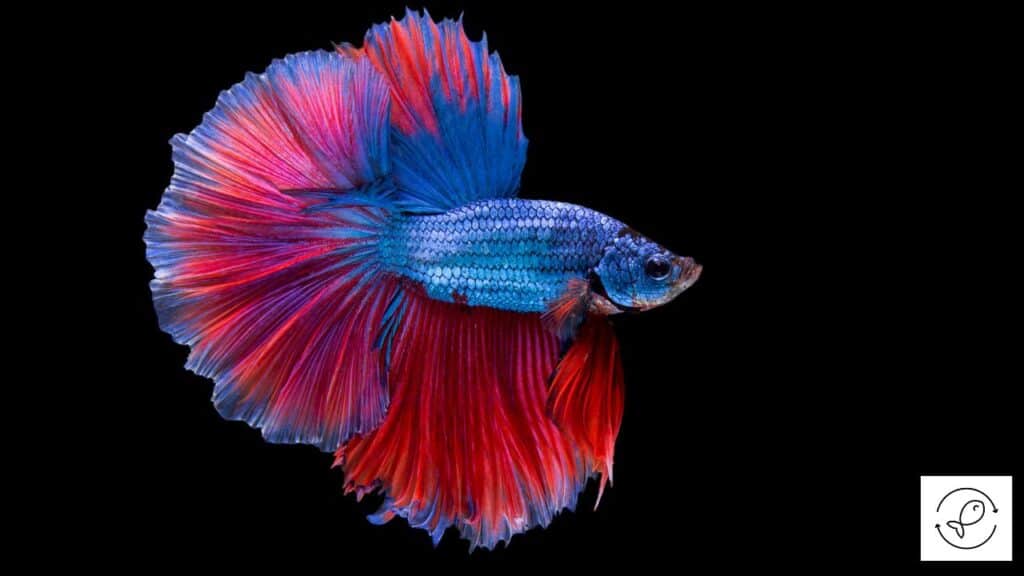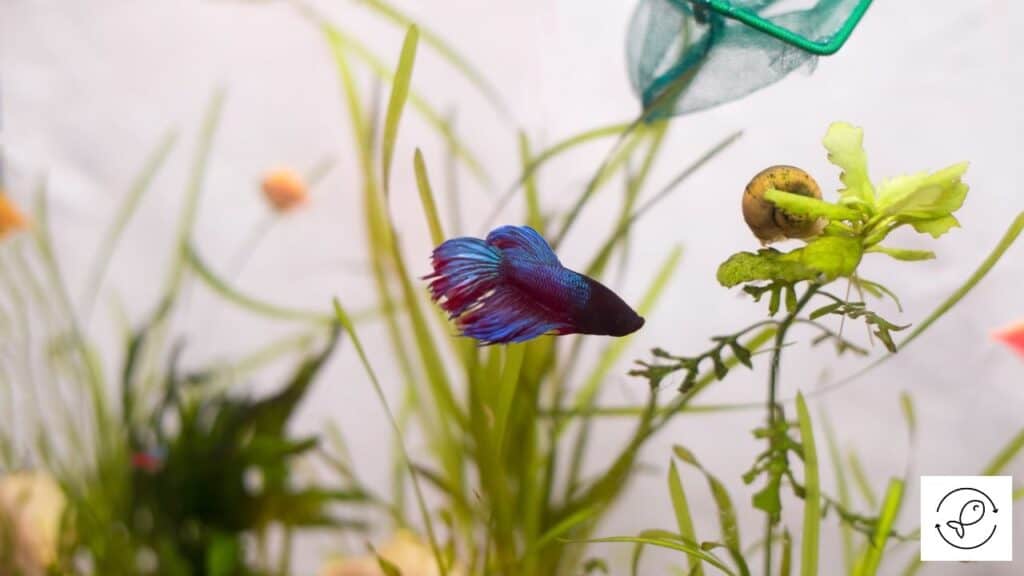Female bettas are semi-aggressive. They become highly aggressive while establishing a hierarchy to create their own space. Unsuitable living conditions also trigger their aggression. However, they aren’t as aggressive as male bettas.
Keep reading to learn more about the numerous reasons for the aggressive behavior of female bettas and practical tips to curb it.
Main Reasons for Female Betta Aggression
Female bettas are usually not very aggressive, unlike their male counterparts.
However, aggression is their natural instinct, and they will fight if provoked or the situation calls for it.
Many different factors can cause aggression in female bettas.
Given below are some of the prominent reasons for aggression in female bettas.
1. Territorial Dispute
Female bettas are highly aggressive when it comes to defending their territory.
Initially, they fight to establish their territory in the tank.
Once the territory and social order are established, they usually live in harmony with other tankmates.
However, female bettas prefer to keep their space private.
Hence, they become territorial when other fish threaten or invade their territory.
They chase and drive the other fish away from their territory and sometimes can even injure the other fish in aggression.
2. Stress
Stress is one of the primary reasons for female bettas to become aggressive.
A stressed female betta is more likely to display aggression toward her tankmates.
Stress can occur due to poor water quality, sudden or drastic changes in water parameters, inadequate lighting, space shortage, high ammonia and nitrite levels, low oxygen levels, and constant bullying.
Signs of stress in female bettas include suffering from recurring illness, loss of appetite, constant hiding, swimming erratically around the aquarium, anxiety, and loss of coloration.
3. Space Constraints
Aggression due to lack of space is more common in captivity than in the wild.
Female bettas are used to living in large waterbodies with ample space to swim around. They like to explore their surroundings.
But in captivity, they are often housed in small community aquariums with less room to move around.
Shortage of space restricts their free movement and irks them, leading to aggression.
Female bettas also feel threatened when other fish encroach on their territory. This can lead to territorial disputes.
Space constraint mainly occurs if the aquarium is too small or overcrowded.
An overcrowded tank also holds less oxygen, leading to stress.
4. Incompatible Tankmates
Female bettas are naturally territorial and aggressive fish, though not as much as their male counterparts.
They are more tolerant than male bettas and hence often kept in community aquariums.
However, their tankmates must be compatible with them to avoid aggression.
Bright-colored fish can trigger aggression in female bettas as they look upon these fish as a threat and competitor.
Also, fish with flowing tails shouldn’t be housed with female bettas because they will get chased.
5. Food Scarcity
Female bettas become hostile when they’re hungry or underfed.
They look upon their tankmates as competitors if the food is scarce.
Competition for food stresses female bettas, leading to aggression. They start to fight for their survival.
Fighting with tankmates during feeding indicates that the supplied food is insufficient for all the tank inhabitants.
Signs of Female Betta Aggression
Given below are certain signs indicating that female bettas are becoming aggressive.
Fin Nipping
The most obvious sign of female betta aggression is when they start biting and nipping at each other’s fins or tails.
This can lead to injury if not stopped quickly.
If the fight is intense, you will notice red marks or chunks of fin missing on the bettas.
Tail-Biting
Tail biting is another sign that indicates female betta aggression.
You will notice your female betta chasing other fish and attempting to bite their tails in anger.
Flaring

Flaring is the most common behavior exhibited by female bettas when they get aggressive.
They will flare their fins and gills in a way that they look bigger.
Flaring is usually done to scare off other fish without being physical.
It’s also used as a warning signal to other fish, often used in their natural environment.
Flaring can lead to aggression in captivity if the other fish doesn’t back off.
Ramming
Ramming is another sign of female betta aggression.
If they don’t show aggression through body posturing, they will likely become physical and fight.
You will notice your female betta hurting other fish by aggressively ramming their bodies.
Behavioral Change
Another sign that female bettas are getting aggressive is sudden changes in their behavior.
You will notice some female bettas becoming more dominant while others become submissive.
Other Signs
You might also notice other signs of aggression from your female bettas, such as missing scales, injured fins, etc.
Some severe side effects of aggression on the female bettas at the receiving end are prolonged hiding, decreased appetite, and lethargy.
If you notice these behaviors, it’s best to immediately separate the female bettas by placing them in different tanks.
If this doesn’t work, try adding more plants to your aquarium.
The more plants in the tank, the less likely the female bettas will feel threatened.
Are Female Bettas Aggressive Toward Each Other?
Female bettas aren’t as aggressive as males. Hence, aquarists often keep a group of female bettas in home aquariums.
Multiple female bettas in the same tank are called a sorority. A sorority of four or more female bettas is recommended.
However, a sorority of more than ten female bettas isn’t recommended.
Female bettas display aggression and engage in conflicts with each other to establish their position in the social hierarchy.
So if female bettas are displaying aggression, it’s usually because they still need to establish order among themselves.
Once they’ve chosen their alpha female, they usually get along well.
The only thing you need to ensure is that the aquarium is large enough for all the female bettas to claim their territory.
Ways to Curb the Aggression of Female Bettas
It’s crucial to understand the housing requirements and behavior of female bettas to maintain peace in the aquarium.
Given below are various ways to curb the aggressive behavior of female bettas:
- Use a suitable-sized tank while housing female bettas because they like to explore their surroundings. A tank with enough space for each fish to claim its territory helps to curb territorial aggression.
- Ensure that the water quality is good. Female bettas need clean, fresh water to thrive.
- Water parameters need to be favorable for optimal growth and reproduction.
- Avoid overcrowding. Overcrowded aquariums lead to stress and anxiety, which triggers aggression.
- Feed an adequate and well-balanced nutritious diet to your female bettas. Regular feeding keeps them active and healthy. It also helps them to stay calm and curbs their aggression. Feeding a nourishing diet also helps to strengthen their immune system, thus making them less susceptible to diseases and other ailments.
- Avoid stressing your female bettas by providing them with a conducive living environment. Factors such as good quality water, stable water parameters, nutritious diet, enough space to claim territory, ample hiding places, and compatible tankmates make female bettas feel secure and stay peaceful.
- Maintain hygiene in the tank through regular tank maintenance. A clean habitat can make female bettas comfortable and go a long way in curbing their aggression.
- Provide ample hiding places for female bettas to rest and take shelter when they feel threatened. Hiding places such as rocks, caves, aquatic plants, etc., can provide them shelter.
- In a community aquarium, other fish species must be compatible with female bettas.
- Aquarium lighting needs to be appropriate. The light intensity must be sufficient to keep the female bettas’ natural circadian rhythm intact. It helps them to stay happy and peaceful.
Are Female Koi Bettas Aggressive?
Female koi bettas are semi-aggressive. They aren’t as aggressive as their male counterparts.
Hence, aquarists often prefer keeping a sorority of female koi bettas together.
A large tank with enough space for each fish to claim its territory is sufficient to prevent their aggression.

